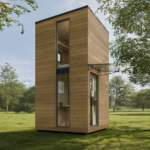A small ecological corner!
Dry toilets are an ecological and economical alternative to our traditional toilets. However, they still (too) often have the label of the austere, and sometimes even hostile, hut at the bottom of the garden!
Do you really know how they work? What are the benefits of these toilets, and how should they be maintained? Quadrapol lifts the mystery on this “little corner” unlike any other, which has nothing to envy to its networked friends!
What is a dry toilet?
Unlike standard toilets connected to the sewer, dry toilets are toilets that do not require water to operate. Remember that the water usually used is clean water for consumption. By choosing dry toilets, you can significantly reduce your water consumption (15,000 liters of water per year per person!) but also your bills! A simple approach that is good for you and the planet!
Dry toilets can be designed in different forms. Most often, the work is made of wood for the seat (box). It is completed by a bucket, placed under the seat. Finally, a container (such as a cup or shovel) and a sawdust bin should also be in close proximity to the toilet.
What are the advantages of dry toilets?
Dry toilets are sometimes mistakenly considered to be from the old days. And that’s a shame, because they are very topical!
First, sawdust and wood chips have the ability to effectively neutralize odors. The idea that one has of a small, unwelcoming corner at first glance is therefore not justified! Secondly, dry toilets are much quieter as there is no flushing. And no flushing means no water, and therefore no leaks. No plumbing work required, and no extra costs in sight!
How do dry toilets work?
The operation of the dry toilet is simple. A first layer of sawdust or wood shavings (litter) should be placed in the bottom of the bucket when it is empty. This should be repeated each time the toilet is used. This process allows the absorption of liquids and avoids odors. A toilet paper for composting will complete the set. Once the bucket is full, it should be emptied onto the home compost, or into a designated area. On average, the bucket should be emptied once a week per person into a compost bin. This can be purchased or simply made by you! You should also know that some municipalities offer financial aid, so don’t hesitate to call your local council!
To facilitate the disintegration of the components, it is advisable to make a depression before depositing the contents of the bucket in the composter. Then mix and finally water the whole. This compost will mature after about two years and can be used to feed the soil and maintain your beautiful garden.
This type of toilet is perfectly adapted for a Tiny House or a lodge in
autonomy
where you can install your little eco-friendly corners without any worry. If you are not in the middle of nature, don’t forget to choose a location for your composter that won’t disturb your neighborhood!
Shavings or sawdust, what to choose and where to buy?
These two elements work perfectly for dry toilet use. However, sawdust, which is finer, is known to be more effective in neutralizing odors.
All types of wood can be used for your dry toilets, but some of them are more adapted. We recommend pine sawdust, for example, which has a very pleasant smell. It is important to choose a chemical-free absorbent, made from untreated and putrescible wood, in order to facilitate its disintegration during composting.
To get chips and sawdust, you can go directly to a sawmill, if you are lucky enough to have one in the area. Otherwise, it is possible to buy from agricultural cooperatives, gardening and DIY stores such as Leroy Merlin or specialized sites such as I CAG
How do I maintain my dry toilet?
Toilet maintenance is mainly based on cleaning the bucket. It is important to choose a stainless steel bucket that is deep-drawn to guarantee a perfect seal. To simplify the emptying of the bucket, compostable bags can be used. Use white vinegar, a natural cleaning product, very effective and deodorizing. Make a mixture with 3/4 water and 1/4 white vinegar, then spray it on and leave it on for about 30 minutes. Then rinse with plenty of water. The wooden toilet seat is cleaned in the same way as a conventional toilet.
The mystery surrounding dry toilets is now over! In case you still have questions, please contact us or leave a comment!





